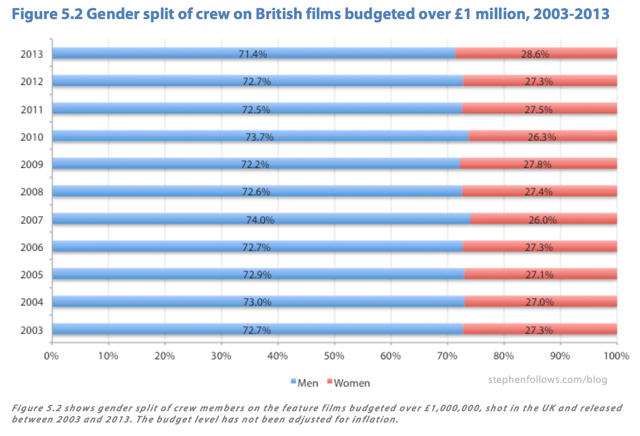
Earlier this year, I published a report into what percentage of crews on the top-grossing US films of the past 20 years are women. I found that, on average, women made up only 23% of a typical film crew and that in some jobs, such as cinematography and composing, it was around 2%.
Then I got lots of requests to look at the situation in the UK. I studied 2,336 UK films to assess the gender of their crews. In summary:
· Between 2009–13, women made up 26.2% of crew members on British films.
· This compares favorably with top US films over the same period (22.2%).
· Of all the departments, the Transportation department is the most male, with only 7.7% women.
· The only departments to have a majority of women are Makeup, Casting, Costume, and Production.
· Visual Effects is the largest department on most major movies and yet only has 16.5% women.
· 6.4% of composers on UK films were women.
· 14% of UK films had a female director, compared with 3% of top US films.
· The percentage of women on British films has barely changed in the past five years.
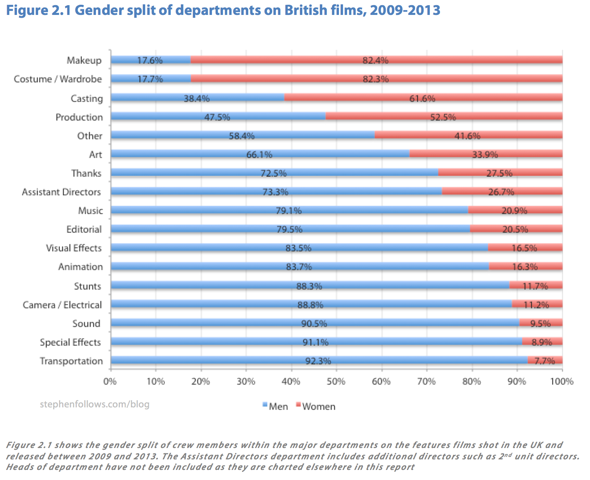
How do UK crews compare with US crews?
This research project focuses on feature films shot in the UK and released between 2009 and 2013. My previous research looked at the 100 top-grossing films at the US box office, the vast majority of which were made and distributed by the major Hollywood studios.*
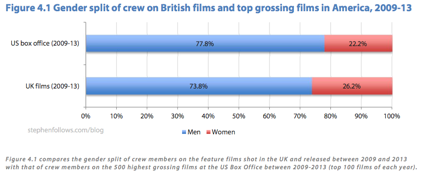
The biggest difference between the UK films and top-grossing US films is in the role of Director. The representation of female directors was 4.5 times higher in UK films than top US films.
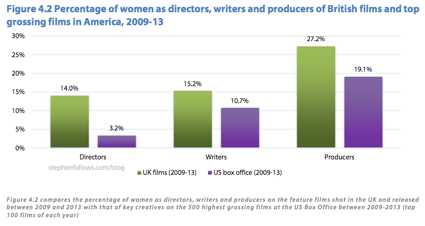
Has it improved over time?
Nope. Just like the US figures, the overall percentage of women in UK crews has stayed static in the past decade.
So what?
An obvious question to ask at this point is, Does it matter? It matters if these figure reveal an inequality of opportunity. i.e., women are having a harder time than men breaking into and progressing within the film industry. Further research is needed to be able to apply data to this conclusion (such as measuring ambition across genders, studying film-school intake, charting other routes into the industry, measuring opinion within the industry, etc). Anecdotally, I know very few female crew members who feel they have had the same treatment as a male counterpart in all situations.
But it also matters for another reason: Films are a large part of our culture. If the films we’re all watching have a skewed perspective on life, then we’re not getting all perspectives. I looked at this issue last year when I studied whether female audiences prefer films made by female filmmakers.
Arguably, the roles which have the largest impact on the final story are writers, producers, and directors. Therefore, the fact that women only account for 15%, 27%, and 14% respectively of those positions must have an effect on the representation of female issues and viewpoints on screen.
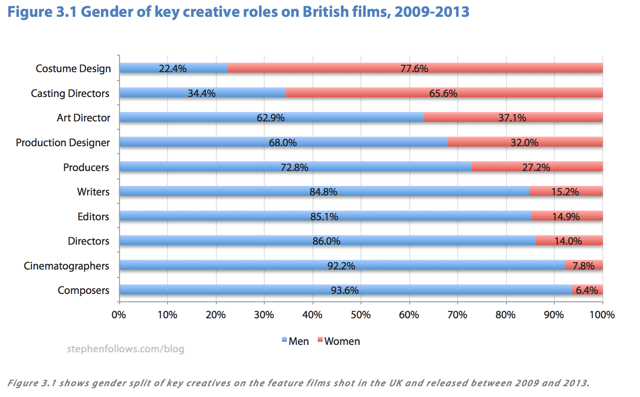
The Full Report
Both this study and the previous one on gender in US crews are too large for a blog article, but you can download the full PDF reports:
· Gender in UK Films Crews http://goo.gl/YBYyuW
· Gender Within Film Crews report http://goo.gl/dGLsNV
Epilogue
This article was based on two sets of data: UK films budgeted over £1 million since 2003 and all films since 2008. Most of the results relate to UK films of all budget ranges, released between 2009 and 2013 inclusive. I used the “over £1 million films” list to look at trends over the past decade.
We are fortunate in the UK that we have an impartial, well-funded, and hard-working body in the BFI. Due to their work, we have reliable data on local films, meaning research such as today’s can be seen as fairly complete. If anyone has complete records for films made in other countries over a similar period, then I would be happy to research the gender split of those films. Just contact me.
My data sources, methodology, and the limitations of this research are detailed in the full report. For brevity’s sake, I have decided to leave them out of this article. If you’re interested in seeing further results, or understanding how I carried out this research, then please download the full PDF report.
* Direct comparisons between the UK and US data sets are a little less robust than I would normally like, as they are studying slightly different things. However, I have run spot-checks and found no significant difference between the overall percentage of women in all UK films and that of just the highest-grossing UK films. This means that comparing the UK film results with the top-grossing US films does reveal useful information about the difference between the two countries.
Stephen Follows is an award-winning writer and producer based in Ealing Studios. Sign up to receive notifications of all his film-industry studies at his site.
